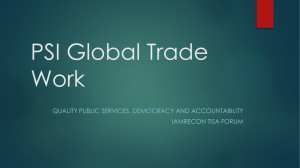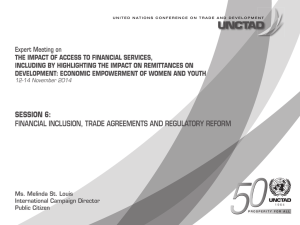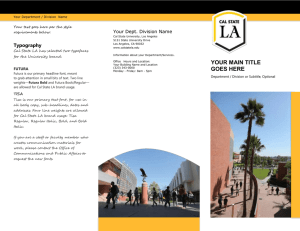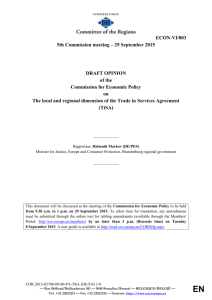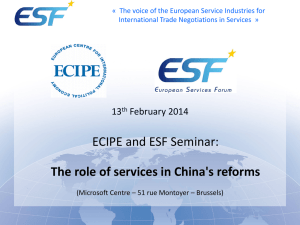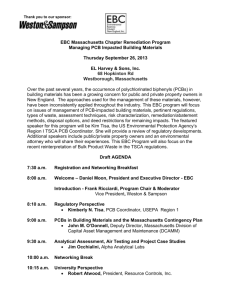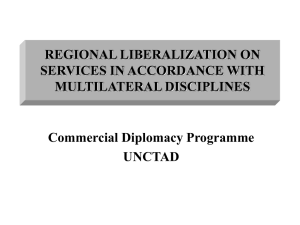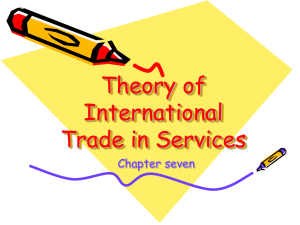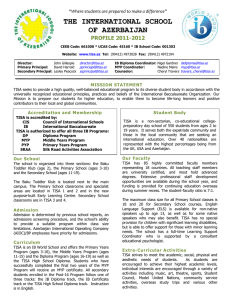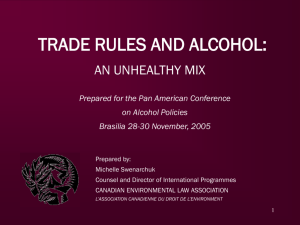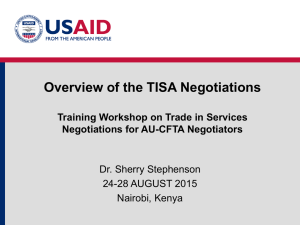PSI Global Trade Work
advertisement
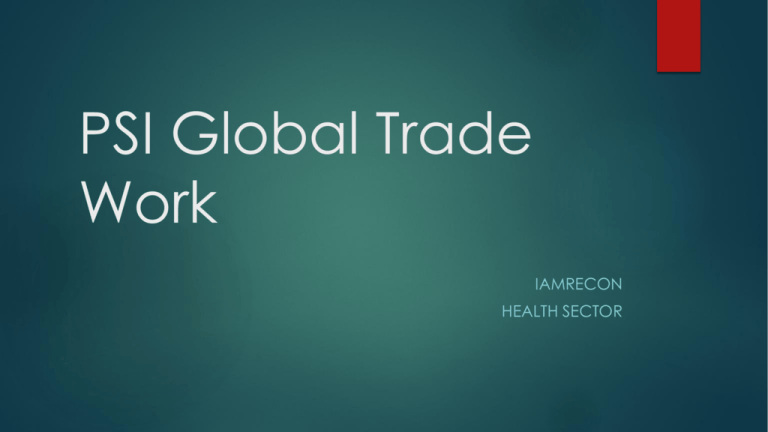
PSI Global Trade Work IAMRECON HEALTH SECTOR The new wave of trade agreements Shift away from multilateral system FTA’s proliferating – over 2000 since mid 90’s Regional trade agreements expanding – new plurilaterals Not transparent – secret, exclusive Not about tariff’s 97% removal of non-agricultural tariff's Investors rights Regulatory coherence Domestic regulation Enforcement - Investor State Dispute Resolution procedures Developing Country Service Commitments: Much greater in US FTAs than GATS Source: UNCTAD 2014 4 Democracy Will bind future governments Negotiations not disclosed to public – mandates, offers, text Will stop governments from delivering services in accordance with mandate (auto insurance case) Enforced with penalties - rare Public Services are not commodities QPS: Provide basic social and economic necessities universally on the basis of need. Exists because markets will not produce these outcomes. Trade agreements: deliberately promote commercialisation and define goods and services in terms of their ability to be exploited for profit by global corporations and international service providers. Trade Agreements Effect Public Services Privatisation Ability to regulate Creates corporate rights that challenge state rights Restrictions on public services Standstill: confining public services within existing boundaries, Dom regs: Restricting governments options for regulating Ratchet: locking in future (failed) privatization and (failed) regulation Negative list: Future services Beyond Non-Discrimination GATS prohibits public monopolies and exclusive service suppliers in committed sectors. Governments cannot restrict or require “specific types of legal entities” through which to supply services. applying ‘pro-competitive’ regulation to previously socialized services Insufficient carve-out for public services GATS excludes services provided “in the exercise of governmental authority.” defined as “any service which is supplied neither on a commercial basis nor in competition with one or more service suppliers.” Domestic regulation Binding rules that allow corporations to challenge new or costly regulations – even if domestic and foreign treated the same Covers qualification requirements, technical standards and licensing requirements Worker safety, environmental, consumer protection, universal service obligations, water standards, municipal zoning, toxic waste transport, educational institutions etc 15 arbitrators alone have captured the decision-making in 55% of the total investor-state cases known today Private, unaccountable, no appeals, no conflict of interest rules Winning gov’t compensation or preemptively chilling government actions, Source: Profiting from Injustice http://corporateeurope.org/publications/profiting-frominjustice Some of the Investor-State Cases Attack on Reversal of Water System Privatization Vivendi v. Argentina: 2007 (France-Argentina BIT). Argentina ordered to pay $105M to firm that cut off water to Buenos Aries. Contract dispute over U.S. $$-denominated rate guarantees unpayable in financial crisis. Attack on Post-revolution Increase in Egypt’s Minimum Wage Veolia vs Egypt: June 2012 (France-Egypt BIT). The company argues that changes to local labor laws – including recent increases in minimum wages – have impacted negatively on the company despite contract provisions designed to buffer the concessionaire from the financial implications of any such legal changes. Attack on South Africa’s Black Economic Empowerment Policy Piero Foresti & Others v. South Africa: Mining investors claim South Africa’s Black Economic Empowerment law violated investment treaties even though it implemented new South African constitution post-Apartheid. Attack on Canadian medicine patent policy by Eli Lilly $500M claim because Canadian high court invalidated patents on 2 drugs that didn’t perform as filed Attack on Canadian Toxic Chemical Ban Ethyl v. Canada – ban reversed, corp. paid $13M for lost profits while ban was in effect – US states ban same chemical, MMT a gasoline additive Attack on Australian, Uruguayan Cigarette Health Laws by Phillip Morris Chevron Attacks Ecuador to halt court-ordered payment for Amazon pollution PSI Work TTIP TTP TISA And how it effects the fight for universal health Why a TISA? • • • • • Services Sector growth 2/3 of GDP but 20% of trade Doha round at a standstill GATS incomplete – TISA extends GATS Aim to pressure other countries to join after conclusion Who does it cover? Canada, Chili, Colombia, Costa Rica, Mexico, Panama, Peru, United States Australia, Hong Kong, Japan, New Zealand, Pakistan, South Korea, Taiwan Iceland, Norway, Switzerland, 28 members of the EU Turkey, Israel 60% of worlds services History of TISA Started in early 2013 Secret negotiations in Geneva every 8 weeks Extension of GATS Heavily lobbied for by USA Coalition of Service Industries Characteristics Deeper commitments (>90% coverage?) Standstill and ratchet clauses (privatisation) Negative list on national treatment (future Domestic regulation (broad as above) services) Not releasing texts, mandates or brackets Who wants the TISA? The Global Services Coalition in a letter to the European Commission explains that the TISA was conceived: “to allay business frustration over the stalled Doha Round outcomes on services.” (September 10, 2013). The US Coalition of Service Industries (CSI) set up a TeamTISA to promote TISA Microsoft JP Morgan Chase CHUBB Deloitte UPS Google Verizon Walmart Walt Disney IBM and more. Who else? Financial Services text from Wikileaks shows that the following organisations support the TISA: US Securities Industry and Financial Markets Association US Chamber of Commerce Canadian Services Coalition Coalición Mexicana de Servicios American Insurance Association VISA Bloomberg Financial information Services What do they want? Walmart in its submissions to the US Trade Representative (USTR) sees the TISA as a way to free itself of restrictions on the sale of pharmaceuticals, medical devices, alcohol and tobacco and avoid zoning laws FEDEX in its submissions to the USTR seeks the elimination of “regulatory advantages historically conferred on national post offices”. In other words it sees the TISA as a way to force the deregulation of the postal system. What services does it cover? cross border services (GATS Mode 1), Telemedicine, online health services, online drug purchases; consumption abroad (GATS Mode 2) medical tourism; foreign direct investment (GATS Mode 3) multinational corporations buying or establishing private hospitals, clinics, laboratories etc temporary movement of persons (GATS Mode 4) such as nurses, doctors, personal carers, health executives temporarily travel abroad to provide services. What provisions does it cover? Necessity test Cross subsidies Decision making cant involve undue delays Licensing Trans-Pacific Partnership (TPP) Effects on Health System Delayed access to generics by patent extension to 20 years and 5 years for changes (ever-greening) i.e. delivery, indications Health technology & procedures (IP) Harder to negotiate lower prices for medicines (transparency annex) TPP – Effects on public health Food labelling (technical barriers) Public health policy - Plain packaging (IP) & alcohol (market access) ISDS – squeeze budgets And some more……. State owned enterprises and foreign competition (subsidies) Government procurement – local purchasing Regulatory coherence – greater role for industry in policy making Over-reach: Mood is changing AFL-CIO ETUC TUC DGB Civil Society Washington Forum TISA Forum We are winning China and ‘set the standards’ rhetoric Labour clauses Appropriateness Enforceability Vietnam and Ecuador examples What to do? Understand how the agreements effect your members Understand how they effect workers and democracy Explain more than tariffs and trade Work with civil society allies Reach out to private sector unions Influence your national centre Lobby your government
